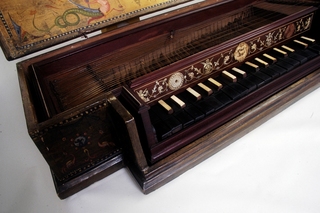Clavicordio Ligato
Board zither with resonator box (314.122-8). It derives from the monochord, chordophone originally used by medieval theoreticians for the mathematical study of intervals. A set of depressing keys added to the instrument raises, when being pressed, the metallics tangents fixed to the key inner section and strikes the strings. This simple mechanism allows to transmit movement from the player's hand to the string directly.
This, in turn, permits to attain subtle touch differences, hence, a subtlety expressivity. Nevertheless due to the soft voice of the instrument, it was relegated for musical training and practice during most part of its existence. Only the empfindsamer Stil (ca. 1760-90) gave importance to its wide range of expresivity and composed a specific repertoire for it.
Though the first representations were done at the beginning of the 15 t h . c, the oldest surviving clavichord (latin clavis = key and chorda = string) dated since 1543. It is Italian. Due to some of its features, the specimen at the museum is supposed to come from Italy too. The outer case does not form part of the instrument, as in other countries, and serves only to protect it from weather changes. Perhaps it is not the original one as the style in its painting is different from that of the clavichord ornamentation, which can be seen even if the instrument is within the outercase. Its consists of strips of ivory and various motifs inlaid with nacre and ivory on the nameboard surface. The keyboard which justs out from the ractangular box is veneered with ivory or black stained wood.
A pair of bridges raise twenty-two double courses, fourteen of which — correspond to the notes C, D, E, F, G and A — are struck by two tangents in different points of their length. This increases the number of keys to thirty-six and, hence, the compass to three octaves. This system, called fretted, is found in all instruments made before the year 1700.
Label: B, C, D, E, F [...] G, A, B L. 30.4 x w. 80 x h. of the instrument 11 cm.
L. 34.7 x w. 86.4 x h. of the outercase 14.2 cm.
Gift, Dr. Emilio Azzarini's Collection, 1964.
Bought in Buenos Aires? (Argentina), ca. 1957. IM 3







